
At the beginning of the year, routines and transitions are important to establish, but after holidays and vacations, routines and transitions are important to revisit. When children return to school following an extended break, some rules and norms may have been forgotten, and many children will benefit from a refresher. At this time, you might also reflect upon how well the routines have worked for your students and if any need to be modified to better suit your classroom community.
The creation and management of classroom routines and transitions allows you to teach effectively and efficiently; allows you to create an orderly, busy classroom in which students know what is expected; as well as how to behave responsibly and respectfully in a community of learners. Students learn how the classroom library is organized, how to choose books and return them, how to use their voices in the classroom, and how to work in organized literacy centers.
Here are 5 Classroom Routines to Revisit Throughout the Year:
1. Listen Carefully to Each Other
When you teach students to listen carefully to each other, they learn to communicate and collaborate effectively.
- Engage students in a demonstration on effective listening behaviors, such as by having a short book talk.
- Follow the book talk with a prompt like: What are some ways we showed that we were listening to each other?
- Create an anchor chart with the whole group to list ways that you can show that you are listening carefully to one another.
- You may wish to follow this lesson with a lesson on Using an Appropriate Voice Level.
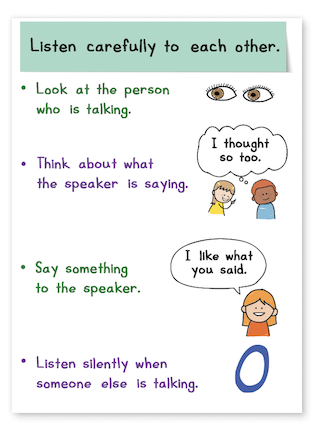
2. Find Ways to Solve Problems When the Teacher is Busy
When children learn different ways to problem solve on their own, it encourages independence and allows time – or the teacher to work with small groups or individually with other children.
- Engage students in a discussion on how to problem-solve independently. Let’s think about some different problems you might have and ways you could try to solve them on your own.
- As students come up with ideas for problems, ask other students how those problems might be solved.
- Create an anchor chart with the whole group to list solutions to a variety of problems.
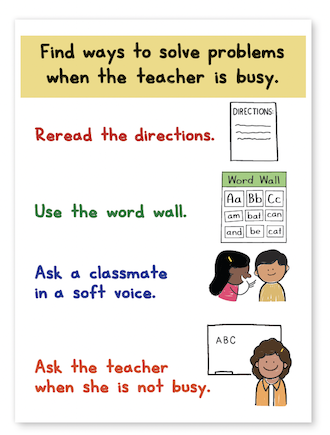
3. Take Good Care of Classroom Materials
When children understand the importance of taking good care of shared materials, including returning them to where they belong, it promotes a positive learning environment by guaranteeing that everyone will have materials to use that are in good shape.
- Engage students in a demonstration on returning classroom materials correctly.
- Follow the demonstration with a prompt like: Where do we keep classroom materials that you use for activities?
- Invite volunteers to get materials, use them properly, and return them.
- Create an anchor chart with the whole group to list the rules to follow when using classroom materials.
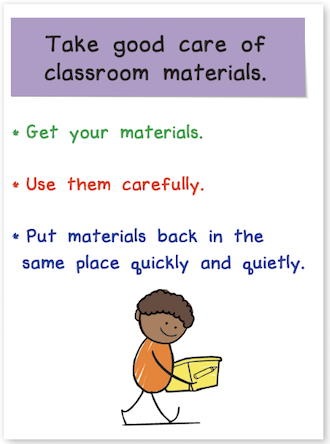
4. Keep Your Books and Materials Organized in Your Personal Box
When you teach children to keep their materials organized, they spend less time trying to find materials and more time reading, writing, and learning. A magazine box or cereal box works well – or a personal box.
- Engage students in a demonstration on what a personal box looks like when organized.
- Demonstrate trying to locate a specific item that you can’t seem to find.
- Ask the class, How can I make it easier to find things in my personal box?
- With student’s input, model putting the materials into your personal box in a specific order with the spines facing forward.
- Create an anchor chart with the class that lists the order of the materials.
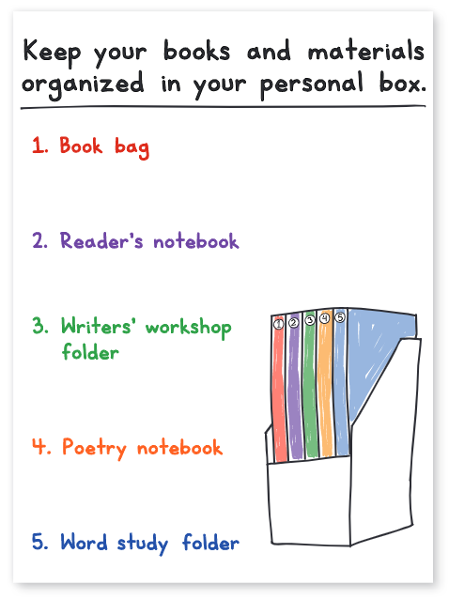
5. Read Books Independently
Children need to know how to work independently. A well-organized classroom environment in which children can work on their own allows time for you to work effectively with individuals or small groups without interruption.
- Engage students in a demonstration on reading books independently. You may demonstrate how reading independently looks, or you may invite a student or two to do so.
- Follow the demonstration with a prompt like, What did you notice about my/their independent reading?
- Create an anchor chart with the whole group to list the steps to follow when you enjoy books during independent reading time.
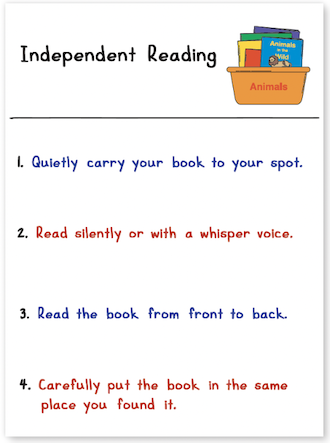
The Goal: A Respectful, Caring, Organized Classroom Community
The goal is to create and maintain a respectful, caring, and organized classroom community. The establishment of rituals and routines supports children’s ability to function as responsible members of the classroom. While explicitly teaching these rituals and routines, it is important to incorporate opportunities to read aloud and talk about books. Interactive read-aloud is a community-building experience that teaches children how to communicate their thinking about books as well as carefully listen and respond to others in a respectful way. Read books from your own library or use books from the Fountas & Pinnell Classroom™ Interactive Read Aloud Collection about school, friendship, and family to discuss what it means to be part of a caring and considerate community. Create a warm and inviting child-centered classroom in which children can take ownership of their own space and materials.



